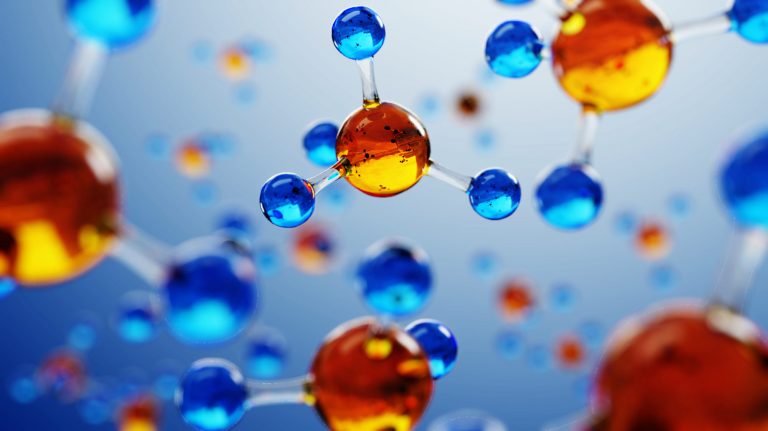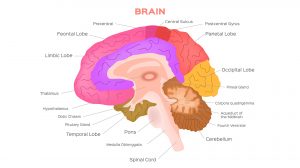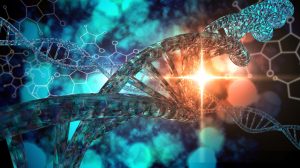Chemical Composition of the Body

The body is comprised of different molecules, which, in turn, are made up of elements or compounds
Table of Contents
In order to fully understand the mechanisms of human physiology, it is important to have an understanding of the chemical composition of the body. This will come in handy when considering the various interactions between cells and structures. We will gloss over the basic chemistry; however, if there are specific questions with regards to chemistry and its effect on biological function feel free to ask on the Forum.
Atoms
An atom is the smallest unit of matter with unique chemical properties. Atoms are the chemical units of cell structure. They consist of a central nucleus with protons and neutrons and orbit(s) of electrons. A proton carries a +1 positive charge, while a neutron has no charge. Thus the nucleus has a net positive charge. Electrons carry a –1 negative charge and are consequently attracted to the positive nucleus. In general, the number of protons usually equals the number of electrons. Recall that atoms have unique (individual) chemical properties, and thus each type of atom is called a chemical element, or just element.
Atomic number refers to the number of protons in an atom, while atomic weight refers to the number of protons and neutrons in an atom, measured in daltons. It is possible for elements to exist in multiple forms, called isotopes; the only difference is the number of neutrons in the nucleus, while protons and electrons always stay the same as the original element.
The human body depends upon four major elements for form and function: Hydrogen (H), Oxygen (O), Carbon (C), and Nitrogen (N).
Bonding
Atoms form molecules when two or more are bonded together.
A1—bond—A2 = Molecule: A1A2
Covalent bonds are formed when electrons in the outer orbit are shared between two atoms. With this type of bond formed, molecules can rotate around their shared electrons and change shapes. Every atom forms a characteristic number of covalent bonds. The number of bonds depends on the number of electrons in the outer orbit.
For example:
- Hydrogen (H) has atomic number 1, with 1 electron in its outer orbit. Hydrogen forms 1 bond (single bond) meaning: 1 electron is shared.
- Oxygen (O) has atomic number 8, with 6 electrons in its outer orbit. Thus Oxygen forms 2 bonds (double bond) meaning: 2 electrons are shared.
- Nitrogen (N) has atomic number 7, with 5 electrons in its outer orbit. Nitrogen forms 3 bonds (triple bond) meaning: 3 electrons are shared.
- Carbon (C) has atomic number 6, with 4 electrons in its outer orbit. Carbon forms 4 bonds, meaning: 4 electrons are shared.
In general: # of electrons in outer orbit + Shared electrons = 8 (full octet)
Make note that any electron shared is in an attempt to reach a stable state. In most atoms, this is an octet, or eight electrons in the outer orbit. Note Hydrogen only has space for 2 electrons in its outer orbit, one present and one shared.
Ions are atoms with a net electric charge due to the gain or loss of one or more electrons. Ionic bonds are bonds formed between two oppositely charged ions. Cations are ions with a net positive charge, while anions are those with a net negative charge.
Ionic forms of elements are important to the body, as they are able to conduct electricity when dissolved in water. These ions are called electrolytes. Single atoms, or atoms that are covalently linked in molecules can undergo ionization. See examples below.
NaCl ↔ Na+ + Cl–
R-COOH ↔ R-COO- + H+
R-NH2 + H+ ↔ R-NH3
Where R is any molecule attached to the shown functional group.
An atom with a single electron in its outermost orbital is known as a free radical. Free radicals are highly reactive and short-lived. In organism terms, they are responsible for the cellular breakdown. Sun damage is a classic example of free radicals acting on skin cells.
Polar bonds are bonds in which the electrons are shared unequally. The unequal sharing gives the atom with the higher share a more negative charge and the one with the lower share of electrons has a slightly more positive charge.
Hydrogen bonds are weak bonds between the hydrogen atom (more positive, the lesser share of the electron) in one polar bond and an oxygen or nitrogen atom (more negative, greater share of the electron) in another polar bond.
H–O- – – – – – – – -H–O–H
|
H
(Molecule 1) (Molecule 2)
Hydrogen bond between hydrogen of one water molecule and the oxygen of another. These bonds are rather weak.
Water
Water is the most common molecule in the human body (~98-99%). Both hydrogen atoms are attached to the single oxygen atom by polar bonds. The oxygen has a slightly negative charge and the hydrogen atoms each have a slightly positive charge. This allows for hydrogen bonds to form between the positive hydrogen atoms and the negative oxygen atoms of neighboring water molecules. The state of water is determined by the weak hydrogen bonds. The bonds remain intact in low temperatures and the water freezes. When the temperature rises the bonds weaken and water becomes a liquid. If the temperature is high enough the bonds will completely break and water becomes a gas.
Solutions
Substances dissolved in a liquid are called solutes, while the liquid itself is called the solvent. The term solution refers to the final product when solutes dissolve in a solvent.
Since water is the most common molecule in the human body, it should be no surprise that water is the most abundant solvent. In the body, a majority of the chemical reactions involve molecules dissolved in water. Hydrophilic (water-loving) molecules are molecules that easily dissolve in water. Generally, hydrophilic molecules have polar groups (e.g., OH-) and/or ionized (e.g., COO- or NH2+) functional groups attached. In contrast, molecules that are not attracted to water are called hydrophobic molecules (water-fearing). They are molecules with electrically neutral covalent bonds (e.g., molecules with carbon chains). When non-polar molecules are mixed with water two phases (layers) are formed. A good example is mixing oil and water and then allowing the container to set for a while. There will be two distinct layers visible.
Molecules with a polar/ionized region and one end and a non-polar region at the other end are called amphipathic, as the molecule has both hydrophilic and hydrophobic characteristics. If amphipathic molecules are mixed with water, the molecules form clusters with the polar (hydrophilic) regions at the surface, where they will come into contact with water, and the non-polar (hydrophobic) regions nestled in the center of the cluster away from contact with water. The arrangement will increase the overall solubility in water.
Concentration
With regards to solutions, concentration is the amount of solute present in a unit volume of solution. Concentration values do not reflect the number of molecules present.
Acidity
An acid is a molecule that releases protons (hydrogen ions) in solution. Conversely, a base is a molecule that can accept a proton. Acids and bases can be further divided into strengths. A strong acid is an acid that releases all of its hydrogen ions in solution. Hydrochloric acid (HCl) is an excellent example of a strong acid. Weak acids are those which do not completely ionize, or lose their hydrogen ions, in solution. The concentration of free hydrogen ions (protons) is referred to as the acidity of the solution. The unit is pH = -log [H+] where [H+] is the concentration of free hydrogen ions. pH is a very important concept in biological systems, and certainly holds great weight in the processes of human physiology. Pure water is called a neutral solution and has a pH value of 7. Alkaline solutions are also known as basic solutions and thus have a lower concentration of hydrogen ions [H+]. The pH of alkaline solutions is greater than 7. Acidic solutions have a high concentration of hydrogen ions [H+]. The pH of acidic solutions is less than 7. Each number on the pH scale indicates a 10-fold change in hydrogen concentration [H+]. Litmus papers are test strips that determine pH based upon color changes in the paper after the strip is dipped into a solution.
Organic molecules
Organic molecules contain carbon backbones. Every carbon atom will form 4 covalent bonds with other atoms, specifically other carbon atoms as well as hydrogen, nitrogen, oxygen and sulfur atoms. By linking together of many smaller molecules, carbon is able to form very large polymers (macromolecules) many of which are important to human physiology.
Carbohydrates
These important carbon-based molecules are vital to life in that they provide cells with energy. Carbohydrates are composed of carbon, hydrogen, and oxygen in a set proportion. Where n is any whole number, the formula is: Cn(H2O)n.
H— C —OH
Carbohydrates are easily soluble in water due to the polar hydroxyl (OH-) groups. Most are sweet tasting and are also known by the common name: sugar.
Monosaccharides are the simplest sugars. Glucose (C6H12O6) is the most abundant and is called blood sugar because it is the major monosaccharide in blood. The common monosaccharides in the body contain 5 or 6 carbon atoms and are called pentoses and hexoses, respectively.
Disaccharides are carbohydrates composed of two monosaccharides linked together. Sucrose is composed of glucose and fructose. Maltose is composed of glucose and glucose chains. Lactose, milk sugar, is composed of glucose and galactose.
An oxygen atom links together monosaccharides by the removal of a hydrogen atom from one end and a hydroxyl group from the other. The hydroxyl group and the hydrogen combine to form a water molecule. Therefore, hydrolysis of a disaccharide will break the link formed and disconnect the two monosaccharides.
Polysaccharides are formed when many monosaccharides link together into long chains. Glycogen in animal cells and starch in plant cells are both composed of thousands of glucose molecules linked together.
Lipids
Fats to the layman. Lipids are predominantly composed of hydrogen and carbon atoms linked together by neutral covalent bonds. Lipids are non-polar and are consequently are not very soluble in water. There are four main classes of lipids to be aware of in learning about human physiology.
Fatty acids are chains of carbon and hydrogen atoms with a carboxyl group at one end. Generally, they are made of an even number of carbon atoms because they are synthesized by linking together fragments composed of two carbon atoms. If all the carbon atoms are linked by single covalent bonds the chain is called a saturated fatty acid. If the chain is composed of double bonds, the chain is called an unsaturated fatty acid. Furthermore, if only one double bond is present in the chain, then it is a monounsaturated fatty acid, while if there is more than one double bond present it is called a polyunsaturated fatty acid.
Triacylglycerols, or triglycerides, account for the majority of lipids in the body. They are formed by linking each of the 3 hydroxyl groups of glycerol with the carboxyl groups of three fatty acids, hence the “tri” in the name. When a triacylglycerol is hydrolyzed, the fatty acids are released from the glycerol and the products can be metabolized in order to provide energy for cell functions.
Triacylglycerols have a near relative called phospholipids. The only difference is that one of the hydroxyl groups of the glycerol is linked to a phosphate. A phospholipid has a non-polar region in the fatty acid, thus the molecule is amphipathic. Phospholipids are very important in building membranes within the body.
Finally, steroids are composed of 4 interconnected carbon atom rings. They may have a few polar hydroxyl groups attached to the rings. Steroids are not soluble in water due to their polarity. Sex hormones, such as testosterone and estrogen, are examples of steroids, as well as cholesterol and cortisol.
Proteins
In addition to the common four elements of carbon, hydrogen, oxygen, and nitrogen, proteins also contain sulfur and other elements in small amounts. Proteins are very large molecules of linked subunits called amino acids. They form very long chains.
Amino acids are composed of an amino (NH2) and a carboxyl (COOH) group that are linked to a terminal carbon atom. Where R is another functional group or carbon chain, known as the amino acid side chain.
H
|
R—C—COOH
|
NH2
The proteins in living organisms are composed of the same set of 20 amino acids. Each amino acid is distinguished by its side chain (R).
As amino acids are joined together with peptide bonds they are forming a polypeptide or a sequence of amino acids linked by peptide bonds. A peptide bond occurs when the carboxyl groups of one amino acid forms a polar covalent bond with the amino group of another amino acid. In the formation of this bond one water molecule is released. The newly formed molecule will then have a free amino group at one end and a free carboxyl group at the other, which allows for linking additional amino acids.
Glycoproteins are made when monosaccharides are covalently bonded to the side chains of specific amino acids in the protein (polypeptide). The specific amino acids that are singled out in the formation of a glycoprotein are serine and threonine.
Protein Structure
Two things determine the primary structure of a protein.
- The number of amino acids in the chain
- Where each specific amino acid occurs in the chain.
It is important to remember that a polypeptide chain is flexible as each amino acid can rotate around its peptide bonds. Therefore, polypeptide chains can be bent into a number of shapes or conformations. The three-dimensional conformation of a protein plays an important role in its functioning in the body.
Conformation of proteins is determined by several factors:
- Hydrogen bonding between neighboring parts of the chain and any water molecules
- Any ionic bonds between polar and ionized parts along the chain
- Weak bonds called van der Waals forces between neighboring non-polar regions of the chain
- Covalent bonds linking side chains of two amino acids
An alpha helix conformation is formed when hydrogen bonds form between the hydrogen linked to the nitrogen in one peptide bond and the double-bonded oxygen in another. The hydrogen bonds contort the chain into a coil. When hydrogen bonds form between peptide bonds in regions of the polypeptide chain that runs parallel, a straight and extended region forms called a beta-sheet conformation. The alpha-helix and the beta-sheet conformations are very common. When ionic bonds form between side chains, and thus interrupt with any repetitive hydrogen bonding, irregular regions called loop conformations may occur.
It is worth knowing that multimeric proteins are proteins consisting of more than one polypeptide chain. The chains can be similar or different.
Nucleic Acids
Nucleic acids store, transmit and express genetic information. Nucleic acids are composed of subunits called nucleotides. Nucleotides contain a phosphate group, a sugar and a ring of carbon and nitrogen atoms. The ring is also known as the base because it can accept hydrogen ions (protons). Nucleotides are linked together by bonds between the phosphate group of one nucleotide and the sugar of the next one. In this fashion, nucleotides form long chains. DNA (deoxyribonucleic acid) stores genetic information in the sequence of the nucleotide subunits. RNA (ribonucleic acid) uses the information stored in DNA to write the instructions for linking together specific sequences of amino acids in order to form polypeptides per original DNA instructions.
DNA nucleotides contain a five-carbon sugar called deoxyribose. DNA has four different nucleotides that correspond to four different bases. The purine bases adenine (A) and guanine (G) are composed of two fused rings of nitrogen and hydrogen. The pyrimidine bases cytosine (C) and thymine (T) are made of only one ring of nitrogen and hydrogen. Guanine and cytosine pair, while thymine and adenine pair. One purine paired with one pyrimidine.
A DNA molecule looks like a double helix. It consists of two chains of nucleotides coiled around each other held by hydrogen bonds between a purine base on one chain and a pyrimidine base on the other.
RNA is slightly different than DNA. Specifically, RNA is a single chain of nucleotides, contains the sugar ribose, and the pyrimidine base uracil is present instead of thymine. Uracil can, therefore, pair with the purine adenine.
You will also like...

Homeostatic Mechanisms and Cellular Communication
Homeostasis is the relatively stable conditions of the internal environment that result from compensatory regulatory res..

Neurology of Illusions
Illusions are the perceptions and sensory data obtained from situations in which human error prevents us from seeing the..

Fruits, Flowers, and Seeds
This tutorial deals with the structure and function of flowers, fruits, and seeds. Also included here are the types of f..

Biological Cell Introduction
It only takes one biological cell to create an organism. A single cell is able to keep itself functional through its 'mi..

Human Neurology
Human Neurology deals essentially with the nervous system of humans. It also features the various theories put forward b..

Evolution of Life – Ancient Earth
Autotrophs flourished, absorbing carbon and light. Soon after, primitive life forms that could assimilate oxygen thrived..
